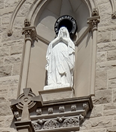Blog:Separation from God: free will, sin and willful damnation
** page under construction **
Then Jesus straightened up and said to her, “Woman, where are they? Has no one condemned you?” She replied, “No one, sir.” Then Jesus said, “Neither do I condemn you. Go, from now on do not sin any more.” (Jn 8:11)
As across Salvation History, here we have the blessing and the correction -- called a "curse" in the Old Testament: "Go, from now on do not sin any more."
There has been much wonder and academic debate over this passage. Some scholars say it was added to the Gospel of John well after its writing, and is thus inauthentic. Others say it was in the original manuscripts but dropped for a time for fear that the passage legimized adultery. The NAB (Revised), a Catholic Bible, notes that the passage was likely inserted into Latin versions of the Bible, presumably, then, in the Vulgate translation started by St. Jerome in 382 (see footnote on Jn. 8:1). Scholars note that the text is reads more like Luke than John, but was inserted into John Chapter 8 in order to align with Jesus' admonition to the pharisees Jn 8:15, "You judge by appearances but I do not judge anyone." (as well as for the allusion within the story in Jn 8:6 to Jer 17:13, "they have forsaken the LORD, source of living waters"). We'll go here with the end of the 8:1 footnote 's clarification, "The Catholic Church accepts this passage as canonical scripture." Indeed, there is no mistaking that the passage reflects the authentic Christ: repent, and believe (Mk 1:15)
"Sin no more"
John the Evangelist called the miracles of Jesus "signs", and for good reason, as Jesus performed miracles to instill or affirm belief. As such, incidents such as the Woman at the Well and here, the Adulterer, involve no outright miracle, and are more powerful for it. Jesus knew his audience, and he knew who needed what and when.
The miracle here is his forgiveness of sin and the belief he instils as result, for, indeed,
Blessed are those who have not seen yet believe.(Jn 20:29)
As with other encounters with the living Christ, we cannot help but wonder what happened to this woman afterward. Like the Leper, the Woman at the Well, the Tax Collector, we can only hope and pray they sinned no more - which together with withholding judgment makrs the primary lesson for us in the story.
** under construction **

